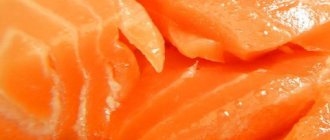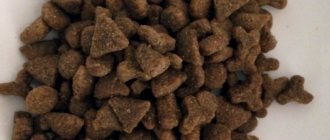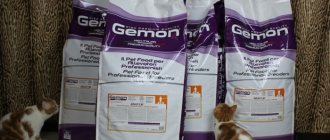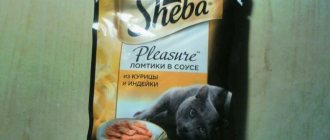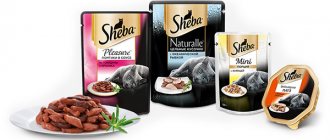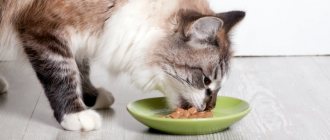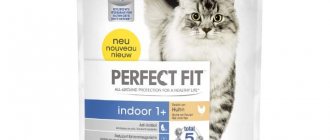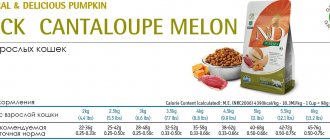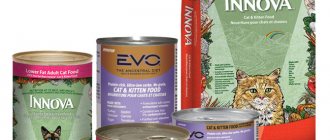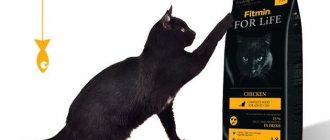The health of pets largely depends on their diet. Today, most of them eat industrial powdered formula. And in order to choose the right food for your cat, you need to be able to decipher its composition. Let’s say right away that you shouldn’t buy economy class food, they contain a lot of ingredients and flavorings that are harmful to animals, it is better to give preference to premium and super premium classes.
How dry industrial mixtures are produced
Before a brand is approved for release, feline nutritionists work. They develop and approve the composition of the final product.
According to the finished recipe, all components are mixed in special units: meat, offal, vegetable raw materials, additional ingredients - preservatives, stabilizers, additives. The finished mass is pressed through a sieve, the cells of which have the shape of future granules.
After drying, the finished pieces are treated with a special composition - a mixture of fat and ingredients that give the food a taste that is attractive to the cat.
Meat after drying cannot occupy more than half the volume, its usual rate is lower - about 35 percent, therefore, if it is not in first place in the list on the product label, this is normal.
The advantage of any food is the absence of flavors and dyes, components that are clearly harmful to animals.
The daily intake of the mixture is also important - the lower it is, the more nutritious the food.
The moisture content of dry food is always no more than six percent.
Sources of carbohydrates
As noted above, eating plant foods is not typical for obligate carnivores, which include cats. But the truth of life is that it is impossible to make dry food exclusively from minced meat: to form stable granules you need a binding component. If it is added only for technological purposes and is in the composition list after meat ingredients, everything is in order.
But there are ready-made diets where sources of carbohydrates (mainly cereals) are used as a cheap filler, which at the same time helps to increase the calorie content of the product and bring the protein level to normal. At the same time, the meat content in the food remains critically low, which means it does not meet the needs of the predator. It is easy to recognize such a product: cereals will be in the first positions in the list of ingredients.
It happens that a manufacturer uses two or more types of grain, such as corn and rice. In this case, they will move to the middle of the list, but the overall percentage of carbohydrate components will still be high.
When comparing two cat foods of similar quality, it is better to give preference to the one that does not contain grains. Legumes, which have a significantly lower glycemic index, are an excellent alternative to grains.
Wet food
They can be considered an intermediate link between canned food and dry mixes.
The main difference is humidity and packaging. These are usually single-dose food packets that are soft morsels in a jelly or sauce. Their humidity is much higher than that of dry food, but lower than that of canned food and is no more than 35 percent.
If the cat does not finish the portion, it quickly dries out and becomes unusable. You can put half a sachet in a bowl, open it and store it in the refrigerator.
Which brand of food should I choose?
The specific manufacturer is not particularly important. The most important indicator is the class and composition of the feed. Note that many popular manufacturers have several factories in different countries. And although they indicate the same composition on the packaging, the quality of the food can vary significantly depending on the country in which the food is produced.
The main condition is that the food must meet the dog’s needs; the company does not matter. At the same time, the ranking is topped by the same brands from year to year, so the owner will have to make a choice among a small list.
Canned food - production and difference from dry food
Wet food is produced similarly to dry food, but instead of drying, the technology includes preservation of the semi-finished product.
The moisture content of canned cat foods - purees, stews, jelly, mousses and others - reaches eighty percent. It is important to know it in order to correctly determine the composition of other components, most importantly - proteins and fats.
For example, at 80% humidity, the can says 5% fiber content. By calculating this share from the remaining 20% of dry products, you can see that in fact its content is 25%. The same recalculation can determine the content of fats, proteins, and macroelements.
It’s a bad sign if the canned food label contains the words “flavors of.” This only means that the composition contains artificial flavors.
In developed countries, it is prohibited to write “all” on the label, which means that the product consists of 100% one component - meat, fish, etc. This is technologically impossible and is a trick of the manufacturer, a deception.
The best cat foods in the category: holistic
There can be nothing better for your beloved pet than dry food from the Holistic series. These are new generation products that are created by professionals for professionals. The composition of this food is as natural as possible, it contains no preservatives and is as digestible as possible for the animal. In the line of companies producing holistic food, there is an offer for every taste, but not for every budget - such products are very expensive, because they require not only high-quality raw materials, but also special production technology.
Innova Cat and Kitten
Photo: www.catster.com
Average price in the Russian Federation: from 1200 rubles. for 2.7 kg
Why in the rating: this food’s composition is almost perfectly balanced, rich in all necessary substances, and even the protein in it is of animal origin. Thanks to the maximum nutritional value, a cat only needs a small portion to fill up. There are no ingredients in food of this level that could harm the animal.
Disadvantages: Innova Cat and Kitten is one of the most expensive foods and in Russia you can only get it on the Internet. It should be remembered that it contains quite a lot of protein, and therefore it should not be given to castrated animals.
Rating: 10 out of 10
From reviews of Innova Cat and Kitten cat food: “Food with a protein content of about 30% is suitable for extremely healthy and active cats, but will not be very good for neutered animals.”
Acana
Photo: www.tenfingers4paws.com
Average price in the Russian Federation: from 1000 rubles. for 2.27 kg
Why in the rating: this food consists of 80% natural high-quality meat ingredients, and is also additionally rich in lactobacilli and probiotics necessary for animals. But, fortunately, there are no grain crops in it at all. In Russia you can buy both on the Internet and in some veterinary pharmacies.
Disadvantages: Acana’s line of food is quite limited, divided by age, and therefore it cannot offer anything for cats with special needs or patients.
Rating: 9 out of 10
From reviews of Acana cat food: “If the animal is healthy and reacts normally to protein, then there will be no problems with nutrition.”
Raw natural food
A fairly young generation of super premium food. These are natural meat products, usually blast frozen. Every year they become more and more popular among supporters of healthy animal nutrition, since this diet is most similar to the natural one. In our country you can buy such food from American brands Balanced Blends, Darwin's Natural Pet Products, Primal. A well-known domestic brand is Superpet.
Natural food contains fresh raw meat (chicken, turkey, quail, beef, lamb, rabbit), vegetables, eggs (quail and chicken), bran, vitamins and microelements.
The advantages of such nutrition are the absence of vegetable protein, preservatives, flavors and flavor enhancers.
Additives and preservatives
When analyzing the composition of cat food, pay attention to the other ingredients at the end of the list. Useful and desirable:
- probiotic cultures - live microorganisms that inhabit the intestines, promoting better absorption of food and preventing pathogenic bacteria from multiplying;
- sources of fiber (vegetables, unsweetened fruits, other parts of plants) - help the functioning of the intestines and feed the beneficial microflora living in it.
A mixture of tocopherols is used as a preservative in good ready-made diets. It prevents fat from oxidizing, allowing food to be stored for a long time without losing its nutritional value. In addition, natural plant extracts are often used for preservation: rosemary, turmeric, citrus fruits, which have antioxidant properties. Artificial preservatives are best avoided.
Most foods contain vitamin and mineral supplements, although there are no synthetic drugs in the steppes and forests where wild cats live. The predator gets everything it needs by eating its prey whole: muscle tissue saturates the body with protein, fat provides energy, and the liver, kidneys, tripe and cartilage serve as a natural “vitamin supplement.”
The products of the Canadian company Champion PetFoods are created using the same principle: they contain not only muscle meat, but also some entrails rich in vitamins, minerals and other beneficial substances. On this diet, your pet receives almost all the necessary microelements naturally. That's why you won't find long lists of synthetic additives on Acana and Orijen packages: only choline, zinc and copper.
Industrial feed composition tables
The tables list all possible components and evaluate them; those that may be harmful to the cat’s health are separately noted.
Meat ingredients
| Ingredient | Allowed and prohibited components | |
| Meat* | Beef pulp, fat, cartilage, heart, tongue, etc. | |
| Meat by-products | Entrails, bones and blood. There should be no horns, teeth, hooves, fur. | |
| Bird | Carcasses with bones and skin. | |
| Poultry by-products | Bird entrails, bones and blood. No - feathers. | |
| Flour | meat | Dried and ground meat and offal. Cannot contain bones, blood, fur, feathers, hooves, horns, etc. |
| meat and bone | Dried and ground meat, bones and offal. Phosphorus content – not less than 4%, calcium – 8.8%. The protein content (digested with pepsin) is no more than 12%. | |
| from offal | Dried and ground meat and offal into flour. | |
| Hydrolyzed protein | Protein broken down into amino acids. According to manufacturers, it does not cause allergies in cats. The nutritional value and safety for the animal are questionable. | |
| Bacon | Natural flavor. | |
| Bouillon | A decoction of meat and bones (the label should indicate what it is from - pork, fish, etc.). Typically includes monosodium glutamate. A good alternative to water to increase feed moisture. | |
| Fat | beef | Natural attractant, source of Omega-6 acids. |
| chicken | ||
| Chicken oil – rendered internal fat | ||
| Skim milk | Typically used only in kitten foods. Contains protein and lactose, which are not digestible by adult cats. | |
| Porcine plasma | Low quality protein from: | blood. |
| Egg powder | crushed and dried eggs. | |
*Meat - beef, pork, goats, sheep - do not require the type of animal to be indicated on the label. Poultry, venison, buffalo and others - species must be specified.
Cereal ingredients
| Fillers forming feed granules | ||
| Ingredient | Is the source, properties | |
| Corn starch | Carbohydrates | |
| Flour | corn | Carbohydrates and plant proteins. |
| oatmeal | ||
| wheat | ||
| rice made from polished white rice | ||
| Wheat gluten | ||
| Beer rice | In high quantities it destroys taurine. | |
| Tapioca | In the form of starch and flour. Low protein, high carbohydrates. | |
| Other components | ||
| Pea protein | Low quality vegetable protein. | |
| Corn gluten | ||
| Pea flour | Crushed fried peas improve the digestibility of pea flour. | |
| Dark rice | Carbohydrates, proteins, vitamins, minerals. In high quantities it destroys taurine. | |
| Barley | Source of dietary fiber. | |
Vegetables and fruits, greens
| Fillers forming feed granules | ||
| Ingredient | Is the source, properties | |
| Sweet potato | Carbohydrates and dietary fiber. | |
| Blackberry | Dietary fiber. | |
| Potato starch | Carbohydrates. | |
| Other Ingredients | ||
| Carrot | Dietary fiber. | |
| Plantain | ||
| Pumpkin | ||
| Zucchini | ||
| Blueberry | Vitamins and antioxidants, acidifier. | |
| Cranberry | Vitamins, acidifier. | |
| Rosemary | Natural preservative. | |
| Blueberry extract | ||
| Garlic | ||
| Alfalfa | Green sprouts, low quality vegetable protein. | |
| Molasses | Sugarcane waste, calcium and betaine. | |
| Ginger | Normalization of digestion | Removing hairballs. |
| Parsley | Breath freshening. | |
| Thyme | In minimal quantities, toxic, antiparasitic agents. | |
| Garlic | ||
| Yucca | Eliminates and masks unpleasant odors of granules and feces. | |
Lactobacilli
| Lactobacillus acidophilus | Probiotics are substances that contain live bacteria from the body’s own microflora. |
| Bacillus subtilis | |
| Bifidobacterium Thermophilum | |
| Enterococcus Faecium | |
| Bifidobacterium Longum |
Yeast, fiber
| Fillers forming feed granules | |
| Ingredient | Is the source, properties |
| Tomato paste | Dietary fiber. |
| Cellulose | |
| Perilla | A mint type plant. Source of Omega-3 and Omega-6 fatty acids. In concentrated form it causes diarrhea. Considered toxic. Used only in feed produced in China, Korea and Japan. |
| Other components | |
| Chicory root extract | Inulin, prebiotic*. |
| MOS, FOS | |
| Peas and pod | Dietary fiber. |
| Oat bran | |
| Beet pulp and pulp | |
| Flax-seed | |
| Seeds, skin and pulp of tomatoes | Prebiotic. |
| Brewer's yeast | Low-quality vegetable protein, prebiotic*. |
| Rice bran | Dietary fiber in large quantities is destroyed by taurine. |
*Prebiotic is a growth stimulator of living bacteria of the body’s own microflora.
Vitamins and minerals
| Ingredient | Is the source, properties | |
| Iron proteinate | Gland. | |
| Amino acid chelate | cobalt | Amino acids and vitamin B12. |
| magnesium | Amino acids and magnesium. | |
| copper | Copper. | |
| zinc | Zinc. | |
| Yodat | potassium | Iodine and potassium. |
| calcium | Calcium. In minimal quantities it can cause thyroid dysfunction. | |
| Carbonate | calcium | Calcium. Prevents granules from sticking together. |
| cobalt | Vitamin B12. | |
| Sulfate | calcium | These elements. |
| gland | ||
| magnesium | ||
| manganese | ||
| copper | ||
| zinc | ||
| chondroitin | Prevents joint disease. | |
| Phosphate | dicalcium | Phosphorus and calcium. |
| calcium | ||
| tricalcium | + prevents granules from sticking together | |
| Sodium Selenite | Sodium. | |
| Zinc oxide | Zinc. | |
| Betaine anhydrous | Choline substitute. | |
| Sodium bisulfate | Vitamin K, acidifier. | |
| Thiamine mononitrate | B1. | |
| Pantothenate | calcium | B5, pantothenic acid. |
| calcium D | Synthetic pantothenic acid. | |
| Tocopherol | Natural preservative, vitamin E. | |
Dyes, preservatives, attractants
| Ingredient | Properties, characteristics | |
| Flavors | artificial | Synthetic additives with odors. |
| natural | Obtained from natural raw materials, such as fat. | |
| Ascorbic acid | Natural preservative. | |
| Gelatin | Low quality protein, collagen. | |
| Gum | Natural gelling and stabilizing agent. | |
| Caramel | Natural dye. | |
| Sodium | nitrite | Color stabilizer, carcinogen. |
| chloride | Natural preservative, stimulator of water consumption in animals. | |
| Red 3 | Dye, carcinogen. | |
| Ethylenediamine | Iodine. | |
*Attractant is a component that affects a cat’s taste buds, attracting it.
What does a cat need?
Cats are obligate carnivores, meaning their diet consists primarily of meat. Pets need animal proteins and amino acids more than carbohydrates. They need connections not only to obtain energy, but also to ensure the correct functioning of all organs and systems.
In their natural environment, animals hunt small game: rodents, birds, etc. From the stomachs of the victims, cats obtain a small amount of cereals, vegetables and fruits. Products in the gastrointestinal tract of birds and rodents are subject to primary processing with enzymes. In this form, they are relatively well absorbed by the cat’s body, but most of the beneficial substances still leave the intestines unchanged. The resulting plant food helps satisfy the daily need for those microelements that are not found in meat.
When eating natural products, 75–80% of the menu is meat, 10–15% is allocated to offal and 10% is reserved for fermented milk products and vegetables
Like all living beings, a cat needs water, so it is advisable to give it not only dry, but also wet food. The granulated product contains practically no liquid, which can become an additional risk factor if the drinking regime is not followed. Dehydration can lead to problems with the gastrointestinal tract, kidneys, cardiovascular system and other organs. In some cases, wet food is the only acceptable option. For example, my cat has very sensitive digestion: after eating granules, she has blood in her stool. After the examination, the veterinarian said that this is an individual feature, in general the animal is healthy, but it is better to switch to pouches and pates. Hard granules damage the delicate internal lining, which can later cause inflammation and infection. The cat does not have such a reaction to wet food.
Composition analysis by class
The most expensive and high-quality food is super premium food, followed by premium and economy.
The cheapest foods are the most widely advertised and are still in great demand. But you cannot feed a cat such mixtures for a long time.
Premium and super premium food are much more expensive, as they are made from high-quality raw materials and differ only in the percentage of meat ingredients.
Super premium and holistic are the best options as they serve as a complete replacement for raw meat. The high price corresponds to their quality. Even if you switch your cat to natural food, you will have to additionally introduce vitamin supplements, micro- and macroelements into the diet; this option is unlikely to be cheaper.
Economy class
The name of the class of cat food “economy” speaks for itself. These are the most inexpensive, and therefore the lowest quality feeds. Everything is correct and logical. But are they so bad? There are a lot of myths about such food, ranging from the fact that special additives are added there for addiction (after all, supposedly an animal in its right mind will not eat it), ending with the banal excuse that it is poison.
Let's be constructive and face the truth. Economy class cat food is definitely not poison, and no matter how much it wants, the manufacturer cannot add “secret” powders to the food to make it taste attractive and addictive. Information about the contents of the packaging of any product in the Russian Federation is an extremely important responsibility of any manufacturer.
and if any component is found that is not included there, it faces at least a recall of all products, colossal fines, not to mention a hopelessly damaged reputation. After all, the category economy in this sense is always under “special control” of the public in one form or another - just give a reason.
Composition and prices
What about the composition? After all, this is the key question. When producing a complete, balanced diet for cats, the manufacturer always faces a choice between the price of the product and the quality of the product. And speaking about the economy segment, the manufacturer is guided by the following principle:
- Ensure that the food is completely nutritious (that is, by eating only it, the cat will receive all the nutrients necessary for a healthy life)
- Ensure good palatability of the food (after all, if you make food only from corn, not a single cat will eat it)
- Provide an affordable price on the shelf. But we will dwell on the price in more detail.
How can you reduce the price if you look at the composition of the feed?
- Buy cheaper raw materials
- Develop a recipe in which the composition will be complete, but at the same time with a minimum content of “expensive calories” - meat.
- Buy cheaper packaging for feed.
It is important to understand that one of the serious criteria for assessing the class of food is the cost of the “conditional protein” in the food. The more of it, the faster the cat eats, the less food is needed
Economy food contains little protein, cats eat worse and require more food on average. Therefore, the savings are in a sense imaginary - if you really approach this issue scrupulously, then you need to take a calculator and consider what is more profitable.
There are also unscrupulous manufacturers who do not care about cats at all and add dyes, flavors, preservatives, etc. to the composition. Read the ingredients - everything is always there.
List of brands
Economy class cat food includes the following brands:
- Kiteket
- Whiskas
- Friskies
- Felix
- Gourmet
These are the most famous representatives of this class. You can also take the price on the shelf as a guide. If a pouch costs less than 20 rubles = consider it an economy price.
Table of comparative analysis of feed by class
Characteristics of industrial cat food are given in the table.
| Characteristic | Trademark | % meat content | Price 1 kg, rub. |
| Economy | |||
| They contain by-products from meat ingredients, and low-quality grains and soy from vegetable ingredients. Additives include many carcinogens and artificial flavors. The cheapest and most undesirable class of food for a cat’s diet. Lead to indigestion, allergies, and chronic diseases. Sold in all supermarkets and widely advertised. | Whiskas, Friskas, Kitekat, Darling, Felix, Cat Chow (Cat Chow), Purina Van (Purina One), Perfect Fit (often classified as premium, but it does not reach it) | From 4 to 6 | From 80 |
| Premium | |||
| Average quality ingredients used. Quite a high content of animal proteins. Well absorbed by the cat's body with the least amount of indigestible waste. The cost is 20-50 percent higher than economy class. Most often sold in pet stores. | 1st Choice, Happy Cat, Hills, Proplan, Royal Canin, Yams, Probalance | From 10 to 20 | From 250 |
| Super premium | |||
| They have a balanced composition, high nutritional value, and are completely absorbed by the cat’s body. Contains natural meat and high-quality cereals. They do not contain artificial additives, taste improvers or carcinogenic substances. Expensive. Sold only in pet stores. | Monge, Leonardo, Bozita, Nature's Protection | 50 or more | From 700 |
| Holistics | |||
| Protein - only fresh and dehydrated meat and fish. No plant materials. Carbohydrates - potatoes, rice, peas, lentils. No corn, wheat. Only natural preservatives (tocopherols). Fiber - vegetables, fruits, dried berries. Hypoallergenic product. Sold only in specialized pet stores. | Akana, Orijen, Go Natural! (Go Natural), Now, Golden Eagle Holistic Health (Golden Eagle Holistic), Pronature Holistic | 50 and above | From 1450 |
What to look for when choosing and comparing
Cat food analysis takes into account several characteristics. These include:
- country of production (here the leaders are Canada, the USA, Germany, the UK and Denmark);
- consistency of food (dry or wet);
- composition of ingredients (one of the most important factors when choosing and comparing);
- class (economy, premium, super premium, elite).
Among the variety of goods on the shelves of modern stores, it is easy for an ordinary person to get lost. Someone pays attention to the packaging, which is stupid to say the least. Others consider the brand to be popular or not. However, it is easy to make a mistake here too.
The famous name of the manufacturer does not guarantee that the food will be good. Some brands are simply widely advertised, but their quality leaves much to be desired. Other manufacturers are unfairly on the outskirts, but at the same time produce an excellent product.
It is difficult for the average resident to navigate today's variety of products on the shelves of stores and veterinary pharmacies. He simply does not have the knowledge to objectively compare feed composition and other characteristics. The following information, based on expert data, will help solve this problem.
Composition is the main factor in comparison
The composition of the feed is the first thing you should pay attention to when choosing food. cat food research and . A quality product must contain meat , because small predators really need it.
A good meal consists of 35-50% meat. If a product is stated to contain 100% meat (i.e. all), then you should not buy it immediately. Most likely, this is food from an unscrupulous manufacturer who is deceiving the buyer.
The food manufacturer may not be lying in this way, but he is not telling the truth. After all, under the word “meat” there can be something else - cartilage, bone meal, hooves, etc.
There are many such "good" ingredients in cheap food products, and the cat owner thinks that he is buying a real meat product for his pet. That's why you need to look for the decoding (chicken, beef, rabbit) and, if available, take it.
When comparing the composition of cat food, you need to consider how many other ingredients they contain. Ideally, food should contain about 20% protein. Plant fiber (fiber), the product of which consists of a quarter, is good.
Many people are discouraged by the word “offal” on the label. However, it's not bad. Liver, heart, kidneys are very useful for cats and people. It’s good if their composition is about 10%.
When comparing cat food shown on a store shelf, you should pay attention to minerals and vitamins. Their presence is a big plus. In particular, we are talking about B vitamins, as well as C, E, I15, H, K. Of the minerals a cat needs:
- calcium;
- chlorine;
- iron oxide;
- cobalt
. If they are, product comparison wins. Note the owner's favorite sign on the "meat-flavored" label. This means that instead of real meat, the food contains only the taste that is provided by harmful additives. The kitten will happily swallow such a dish, attracted by the aroma, but this can negatively affect its health. Such substances have a harmful effect on the furry body:
- cellulose;
- sugar;
- preservatives;
- antioxidants E320, 321, 324;
- icon H127 (causes cancer).
If you see these ingredients in the food, it's best to put the can back on the counter. Compared to the others, she clearly loses. No caring owner would poison their animal. Moreover, today there are many options and there are many alternatives.
When trying to decide on a purchase and compare multiple emissions, you should pay attention to how much of the product the manufacturer recommends giving your cat per day. The lower this percentage, the better the product.
Comparison of feed by class
As noted above, there are budget, medium (premium), high (super premium) and elite human (holistic) cat foods. Buying cat food in an online store is more profitable than in a market or a regular store, since you will have more choice and the opportunity to read reviews and descriptions of the food.
Holistic and super-premium class
MERA
Country: Germany.
The manufacturer takes into account the type of animal - you can choose food specifically for your pet.
Contains only natural fresh products. The special hypoallergenic formula makes this food safe for dogs with sensitive digestion or allergies.
High proportion of animal protein.
The food contains all the vitamins and nutrients your pet needs, and also contains prebiotics for stable intestinal flora and reliable digestion. The best way to purchase food is on the official website meradog.ru.
Price - from 3875 rub. for 12.5 kg.
Acana
Country: Canada.
A unique feed production process involves processing the ingredients with steam at low temperatures.
The proportion of protein is up to 90%.
A wide range, focusing on the characteristics of dogs.
A rich vitamin and mineral complex in every product of the brand.
The price ranges from 4900 to 6700 rubles per 11.5 kg.
Akana dog food - full review of the line
Piccolo
Country: England.
The main consumer of food is small dogs.
The diet is designed for pets prone to allergic reactions.
Grain is replaced with healthy greens: vegetables, algae.
The proportion of protein is from 65 to 80%.
Price - from 3,500 rubles per 4 kg package.
Orijen
Country: Canada.
The manufacturer takes into account the type of animal and creates a special diet.
The products used are not frozen.
There are no grains.
Wide range, there are medicinal products.
Price - from 6500 for 11 kg.
Orijen dog food - complete review of the line
Wolfsblut
Country: England.
High protein content - up to 90%.
The diet is as close as possible to the type of nutrition of a wolf in its natural habitat.
Natural additives, minimal grain content.
Price - from 7,000 for 15 kg.
Dog food "Wolfsblut" - review of the line
Farmina
Country: Italy.
The manufacturer's line offers both economy class and holistic food.
The share of protein in holistic products is up to 70%.
Wide range of breed feeds.
Price - from 5000 to 8000 per 12 kg.
Farmina - dog food from an Italian manufacturer
Pronature
Country: Canada.
Maximum natural ingredients, modern production lines, minimal processing.
Grains are replaced by vegetables, algae.
The line of foods includes both breed-specific ones or those intended for special needs, as well as universal ones.
Price - from 6000 to 8500 for 13.5 kg.
Applaws
Country: Great Britain.
It contains a large number of vegetables, spices and extracts from medicinal herbs.
The share of protein is up to 75% meat or fish.
All products in the line contain probiotics.
Price - from 3500 to 4800 per 7.5 kg.
Applaws dog food - full line review
Duke's Farm
Country: England.
It contains grains, but of the highest quality, which are quickly absorbed by the dog’s body.
The diet contains vegetables and seasonal berries.
Price - from 6000 for 12 kg.
Savarra
Country: England.
The manufacturer focused on the quality of the product, the line is quite narrow.
The proportion of protein is up to 80%.
Easily digestible grains are present.
Price - from 5500 to 8500 per 12 kg.
Now Fresh
Country: Canada.
The brand is available in almost any store.
Does not contain grain.
High proportion of protein - up to 90%.
Wide range.
Price - from 4500 for 12 kg.
Now Fresh dog food – owner reviews, pros and cons
Owner reviews
Irina K. We tried many foods on the doctor’s advice. From drying, food from Royal Canin came up for the corgi. There are also dry food and canned food. We came to it through experience - the dog really liked it, the fur is fine, there is no scabies or shedding. I'm afraid to try something different, although I often notice new foods in stores.
Oleg. R. Only Akana food suited us. From birth the dachshund was fed it, as recommended by the breeder. Now we feed a diet for adult dogs, we take different tastes. Eats everything. To be honest, the food smells nicer than others we bought.
Vladimir R. I have a big dog - Alabay. He lives in a warm enclosure; he needs high-quality and high-calorie food. Especially in winter. We stopped at Grandorf. We chose the one for allergy sufferers with duck and potatoes. Our dog has a little something - his eyes are red, his whole stomach is covered in spots, it itches. And he really loves to eat something forbidden. This is the food that saves us.
The best foods for dogs' musculoskeletal health
Foods for joint health are especially recommended for large breeds and aging pets. After all, they need an increased portion of chondoprotectors, calcium, phosphorus and vitamin D.
Advance Veterinary Diets Articular Care Senior +7 Years Canine Formula – for aging dogs
5.0
★★★★★
editorial assessment
92%
buyers recommend this product
Articular Care Senior +7 Years is designed specifically for older dogs and maintaining the health of their musculoskeletal system. The food belongs to therapeutic diets and is prescribed by a veterinarian for pathological diseases, during the recovery period after injuries, as well as to support animals with osteoarthritis.
The formula is based on hydrolyzed chicken and salmon protein, as well as processed rice. These ingredients are easy for older dogs to digest.
Concentrated pea protein prevents muscle loss and promotes muscle recovery. Glucosamine, chondroitin sulfate and fatty acids support healthy cartilage tissue.
Lemon verbena extract reduces pain in the joints and slows down oxidative processes. All this helps to increase the pet's activity. Hyaluronic acid is added to prevent joint diseases. Vitamin K reduces the risk of fractures and prevents osteoarthritis.
Pros:
- convenient packaging with a clasp;
- no breed restrictions;
- effective prevention of skeletal diseases;
- well absorbed;
- reduces pain.
Minuses:
- expensive (from 6 thousand rubles for 12 kg);
- wheat and corn flour in the composition;
- may cause an allergic reaction.
Advance Veterinary Diets are suitable for daily feeding of aging dogs. However, the chicken in its composition can cause allergies. At the first sign of intolerance, food should be removed from the diet.
Farmina Vet Life Canine Joint – dietary food for bone disease
4.9
★★★★★
editorial assessment
89%
buyers recommend this product
Farmina Vet Life Canine Joint is a food from the medicinal line of the Italian brand. It is prescribed by veterinarians as an aid to inflammation of the bones or joints. The balanced formula is based on oats and spelled with a low glycemic index. They normalize blood sugar levels and prevent diabetes in animals. The protein component is high-quality chicken meat.
The composition also includes chondroprotectors for the restoration of cartilage tissue. A precisely selected ratio of antioxidants and fatty acids relieves inflammation and pain. The crude fat and oil content is 12%. This ensures the shine of your pet's coat. It also contains extracts of herbs and berries. They aid digestion and are a source of fiber, natural antioxidants and vitamins. The food is available in packs of 2 or 12 kg.
Pros:
- natural composition;
- gradually restores cartilage tissue;
- relieves inflammation and pain;
- has a beneficial effect on the condition of the skin and coat.
Minuses:
- difficult to find on sale.
Feeding an animal with Farmina Vet Life Canine Joint does not replace trips to the veterinarian and complex treatment of problems with the pet’s musculoskeletal system. But it can support the health of the animal, so it is worth using as part of therapy.
Veterinarian recommendations
Veterinary experts highlight a number of tips for selecting food:
- choose from super-premium or holistic classes;
- the packaging must be without tears, the jar must be free of dents and rust. Pay special attention to the expiration date;
- the meat ingredient should come first;
- It is better to feed the dog dry and wet food alternately to normalize the fluid level;
- Do not forget about the characteristics of pets.
According to reviews on the Internet, most veterinary specialists recommend the following foods:
- BELCANDO.
- dr. ALDERS.
- HILLs PD k/d.
- HAPPY DOG.
- BRIT.
However, it is worth choosing food based on the preferences of the pet, its health, and the owner’s wallet.
The best dog food for gastrointestinal diseases
For dogs with sensitive digestion, diets with ingredients that are as digestible as possible are recommended. Microelements and prebiotics are also added to the formula to improve the functioning of the gastrointestinal tract.
Hill's Prescription Diet I/D Canine - Best Canned Food for Dogs with Sensitive Digestion
5.0
★★★★★
editorial assessment
93%
buyers recommend this product
See review▶
Technologists, nutritionists and veterinarians work on the creation of Hill's food. The quality of the supplied ingredients is carefully controlled, each of them is subject to preliminary testing. Daily analysis of finished products is also carried out.
However, Hill's Prescription Diet is a separate line of food that should be included in the daily diet only for pets with significant health problems and after the recommendation of a veterinarian. Canned food is intended for dogs that often suffer from intestinal upset. The manufacturer promises a visible effect after 3 days of feeding.
The mixture is based on turkey and pork liver, with rice and corn added for nutrition. The formula is enriched with flax seed, psyllium, vitamins and minerals. Special fiber not only improves digestion, but also nourishes intestinal cells. Canned food is colored with natural caramel. As a result, the digestibility of the composition reaches 95%.
Pros:
- contains antioxidants;
- consists of highly digestible ingredients;
- natural composition;
- Most pets like the taste;
- There are no breed or age restrictions.
Minuses:
- cost (250 rubles per jar weighing 360 g).
Hill's Prescription Diet I/D Canine canned food is a medicinal food, but it cannot replace a comprehensive examination and therapy of an animal.
Purina Pro Plan Sensitive Digestion - inexpensive super-premium food
4.8
★★★★★
editorial assessment
90%
buyers recommend this product
Purina Pro Plan Sensitive Digestion with Lamb is suitable for dogs with gastrointestinal problems. The manufacturer offers a line for small, medium and large breeds: the granules differ in size for the convenience of the animals. The food is produced in dense bags weighing from 0.7 to 14 kg.
The composition includes lamb and dried poultry protein, the protein share is 25%. Dried chicory root is a source of prebiotics. The formula also includes antioxidants and a vitamin-mineral complex. Sensitive Digestion is clinically proven to improve gut flora and prebiotics are effective in improving gastrointestinal health.
Pros:
- available in most pet stores;
- the presence of vitamins and minerals in the composition;
- convenient packaging;
- low cost for super-premium class (2,700 rubles per 7 kg);
- There are different kibble options for dogs of all sizes;
- contains prebiotics to improve digestion.
Minuses:
- low protein levels;
- presence of ingredients of questionable quality and unknown origin.
Purina Pro Plan Sensitive Digestion contains products from processed plant materials. This component raises questions among veterinarians and dog owners. And the vague wording “lamb” and “poultry protein” does not exclude the presence of offal in the feed instead of pure meat.
GO! Sensitivity + Shine - Grain-Free Formula
4.8
★★★★★
editorial assessment
76%
buyers recommend this product
See review▶
GO! Sensitivity + Shine is a Canadian holistic dry food for dogs with problems with the digestive system. Contains no by-products, gluten, artificial flavors or colors, no corn, wheat or soy. But the high level of fiber (3.5%) cleanses the intestines of toxins, regulates digestion and restores microflora.
The manufacturer offers several flavors to choose from: salmon, venison, turkey, pollock, duck. In any case, the formula implies only one source of high-quality protein in the feed. Carbohydrates include oatmeal, whole oats, potatoes or lentils and peas. It also contains rapeseed oil, a source of vitamin E. Healthy additives in the composition include: apples, flax seeds, quinoa, seaweed, yucca extract, rosemary, chicory root, fatty acids and a vitamin-mineral complex.
The food is nutritious, its calorie content is 3560 kcal/kg. Due to this, the feeding rate is low and the mixture is consumed slowly. The size of the kibble is small, so this diet is suitable for puppies and adult dogs of all breeds. For sale GO! Sensitivity + Shine in 2.72 or 11.3 kg packs.
Pros:
- suitable for puppies and adult dogs;
- convenient packaging;
- rich natural composition;
- economical consumption;
- does not cause allergies;
- thoughtful packaging with Velcro;
- contains a lot of fiber.
Minuses:
- difficult to find in pet stores;
- expensive (about 5,700 rubles for a bag weighing 11.3 kg).
Dog breeders note that the price of this food corresponds to the quality of the holistic class. GO! Sensitivity + Shine is recommended for daily nutrition of animals with problematic digestion or frequent allergies. By the way, its composition has a beneficial effect not only on digestion, but also on the general health of the dog.
Review of the Orijen line for cats
Most Orijen products are intended for daily feeding of cats of all breeds and age groups. The exception is Orijen Fit & Trim, a reduced-calorie food designed for overweight adult cats. In Russia you can buy four types of Orijen cat food; food called Orijen Regional Red is not supplied to the Russian Federation.
Orijen cat food is available in the following packaging sizes: 340 g, 1.8 and 5.4 kg. Cat & Kitten food is also available in 17 kg packaging.
If you compare the compositions of some Orijen cat foods presented on the American and Russian markets, you can find some differences. For example, the content of meat products in Six Fish and Cat & Kitten food in the American version reaches 90%. This is due to the fact that feed produced at a Canadian factory is sold in the Russian Federation, and feed produced at a factory in the American state of Kentucky is sold in the USA. By 2022, the manufacturer promises to complete the construction of a new plant in Canada and supply Orijen feed with 90% animal raw materials to Russia.
On our website you can compare Orijen cat food with food from other manufacturers. To do this, simply move the cursor over the image of the food in its card and click on the “add to comparison” that appears, then click on the “deferred food” tab in the bottom panel. On the deferred food page, check the box next to the products whose compositions you want to compare.
If you found our analysis of Orijen cat food helpful, and if your pet has ever tried this food, please share your opinion with us below or in the food selection card. Reviews from veterinarians about Orijen food will be especially useful for our readers.
